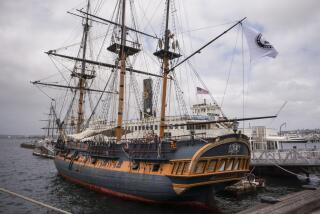Nimble-Fingered Southland Seamen Teach Students the Ropes
Robert Smirl specializes in knots, lashings and whippings. But don’t get the wrong idea. Smirl is not a specialist in mayhem; he’s a seaman who can tie hundreds of sailorly knots and whip a raggedy line into shape faster than you can say “marlinespike.”
Knots, lashings, whippings, splices, seizings and other things you can do with rope are Smirl’s specialties. He is one of only a handful of traditional marlinespike seamen in Southern California.
Technically, a marlinespike is a small metal tool used to separate strands of rope or wire, but in the world of boating, marlinespike is used to describe the entire process of working with rope.
As every boater knows, as soon as you buy a boat--either power or sail--rope becomes very important. You use it to tie your boat to the dock, to hoist a flag, to tow another vessel, to raise a sail. And in some cases, you can even use it to save your life, like the famous sailor Steven Callahan did when he was lost at sea for 76 days and used lines and lashings to repair his ruptured life raft.
Rope, which aboard ship goes by different names depending upon its uses, is an essential part of a seafarer’s life, and it has been a part of Smirl’s life for the past 28 years.
Smirl, a 44-year-old high school English teacher, has been working with marlinespike since he bought his first copy of the “Marlinspike Sailor” when he was 16. Since then, he has taught marlinespike seamanship at Saddleback College and currently is teaching a course at Orange Coast College. Every summer, when he isn’t teaching, he works as the first mate on the Pilgrim II in Dana Point.
“In 1979 I read an article about the Pilgrim,” says Smirl, who lives in nearby San Clemente. “So I went down and volunteered. They were surprised to find out how my marlinespike skills could be used on the Pilgrim. I found myself splicing lines and so on. Pretty soon, I came on board as the rigger.”
Smirl, who describes himself as a traditional marlinespike seaman, says the Pilgrim has been his “mentor” and is constantly teaching him new things--which he then passes along to his students. “For my Orange Coast College class we had a turn-away crowd,” he says. “I have 30 students, which is large for a hands-on class like this.”
Smirl hopes that the size of his current class is evidence of an increased interest in rope work. “We have reached a point in modern boating where you go buy a dock line in a marine store all made up,” he says. “There is no reason to learn the sailorly skills. Most people don’t know how to whip (a line), and they usually only know seven or eight knots. When they take my class, I teach them over 100 knots. And I teach them a lot of the folklore along with the knots.”
Sometimes Smirl even dresses in clothing of the type worn by a 19th-Century whaler. “Many of the whalers were the best at marlinespike because they were at sea so long, three or four years, and had access to lots of junk line,” he says. “So they would unravel it and reweave it into rope or twine that could be used in other marlinespike applications.”
During idle hours, such sailors would use their marlinespike skills to fashion decorative rope work for wives and sweethearts back home. “Macrame, which was popular in the 60s, is a spinoff of the sailorly art,” Smirl says.
Although Smirl’s class deals more with traditional, practical applications, including how to make your own dock lines, another Orange County marlinespike seaman teaches the decorative skills.
John Magness, former first officer on the Queen Mary in Long Beach, began teaching a seven-week class June 28 at Golden West College. Magness, 66, first began working with ropes in the Navy in 1945 when he was stationed aboard the destroyer Phelps. “It was toward the end of World War II,” he says, “and one of the other mates knew quite a bit about the art and taught it to me.”
Among other things, Magness will teach his students how to make a “snowflake” out of one-eighth-inch line. Tying the lacy, decorative snowflake takes Magness five hours. To make a simple snowflake, you have to start with about 80 feet of line, Magness says. “By the time you tie it down, you’ve got about 65 feet of line in it.”
Magness will also demonstrate a variety of decorative knots, including the Turk’s Head, one of the oldest of all decorative knots identified with sailors. Other basic decorative knots that will be covered in Magness’ class include the Carrick Bend and the Turkish Round Mat.
For information on Smirl’s marlinespike class at Orange Coast College, call (714) 645-9412. For information on Magness’ class at Golden West College, call (714) 891-3991.


